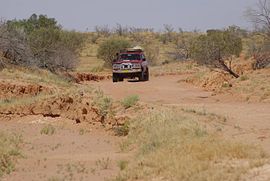| This article is written like a travel guide. Please help improve the article by introducing an encyclopedic style or move the content to Wikivoyage. (May 2011) |
| Bore Track South Australia | |
|---|---|
 | |
| On Bore Track in the Strzelecki Desert | |
| General information | |
| Type | Track |
| Major junctions | |
| South end | Bollards Lagoon |
| North end | Innamincka |
| Highway system | |

The Bore Track is a 4WD track in South Australia roughly following the Queensland border from Cameron Corner to Innamincka. It is a narrow, rarely used, scenic alternative to the Strzelecki Track, passing through sand dunes and clay pans of the Strzelecki Desert. It is a good preparation for the longer traverse of the Simpson desert. There are gas fields, pipelines and bores for which the track is the historic access and after which it is named.
Navigation
The best planning for the trip is to download a GPS track, otherwise navigation may be demanding between the many dead ends and commercial pipeline service roads. Good maps are an asset. Parts of the track may be deep dry sand. Coming from Tibooburra it is worth stopping at the Corner Store of Cameron Corner which is the meeting point of New South Wales, Queensland and South Australia. Follow west until the narrow track takes off at Bollards Lagoon towards the north, passing a dry lake. The southern part of the track goes over farm land with cattle here and there, often around water tanks with windmills. The track ends east of Innamincka, where it is only a short drive to the permanent Cullyamurra water hole of Cooper Creek. Update: the southern section, Bollards Lagoon to the Moomba Rd is now closed to the public.
Camping
Fuel and water should be filled for the number of days planned. Although Cameron's Corner to Innamincka could be made easily in a day.
Wildlife
Especially after rain, the desert flourishes for months with yellow flowers on the dunes and high grass land in the dips. A few small trees or bushes scatter over the landscape and give protections for many birds. Swarms of green and yellow budgerigars can be observed in the evening hours, which are here in their most natural habitat. There may be geckos, lizards and snakes around which can either be seen directly of by reading their trace in the sand.
See also
References
- Hema, Maps (2006). Australia’s Great Desert Tracks (Map). Eight Mile Plains Queensland: Hema Maps. ISBN 978-1-86500-162-3.
External links
- Aerial Video of Innamincka and the Strzelecki Desert
- Mud map
- Rainer's Outback Guide(in German)
- GPS download - route Z17(in German)